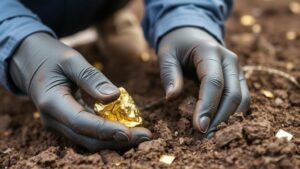Advanced Topics in Gold Metallurgy for Prospectors
Advanced Topics in Gold Metallurgy for Prospectors
Gold metallurgy encompasses various processes for extracting, refining, and processing gold from its ores. For prospectors, an understanding of advanced topics in gold metallurgy can significantly improve recovery rates and profitability. This article delves into some of the sophisticated techniques and considerations in gold metallurgy, tailored for those engaged in prospecting.
1. Understanding Ore Characteristics
Gold is often found in various ore types, each requiring specific metallurgical approaches for effective extraction. Prospectors must analyze the mineral composition, as they influence recovery methods.
- Hard Rock Ores: Typically contain gold in the form of native metal or as an alloy with other metals. Processes such as crushing and grinding are required to liberate the gold particles.
- Alluvial Deposits: Free gold can be found in riverbeds or sediment. Techniques like panning and sluicing leverage gravity separation for efficient recovery.
2. The Role of Gravity Concentration
Gravity concentration is one of the oldest and most effective methods for gold extraction, particularly for coarse gold particles. This method capitalizes on the density difference between gold and other materials.
Common techniques include:
- Shaking Tables: Allow for separation based on particle size and density, enabling higher recovery rates.
- Jigging: Uses water pulses to stratify materials, effectively separating gold from less dense particles.
For example, at the Knelson concentrator, studies have shown up to a 95% recovery rate of gold from alluvial deposits using gravity methods combined with subsequent processing.
3. Leaching Techniques: Cyanidation and Alternative Methods
Cyanidation is the most widely used method for extracting gold from low-grade ores by dissolving gold into a cyanide solution. But, environmental concerns have prompted interest in alternative leaching methods.
- Thiosulfate Leaching: An environmentally friendly substitute to cyanidation that uses thiosulfate as a leaching agent, resulting in lower toxicity.
- Bioleaching: A process utilizing microorganisms to extract metals from ores, showing promise for low-grade and refractory ores.
For example, research has demonstrated that the bioleaching process can recover gold from electronic waste with efficiency comparable to conventional methods, thus opening new avenues for sustainable gold recovery.
4. Innovations in Smelting Techniques
Smelting is a crucial stage in gold metallurgy, where concentrated gold is transformed into bullion. Traditional methods involve high-temperature furnaces, but advancements have led to more efficient and eco-friendly processes.
- Induction Smelting: This method employs electromagnetic induction, reducing energy consumption and improving temperature control.
- Electrowinning: Allows for direct recovery of gold from cyanide solutions, providing a sustainable and cost-effective alternative to traditional smelting.
An illustrative case is the development of a mobile induction furnace that enables field-based gold refining, enhancing the field flexibility for prospectors and small-scale miners.
5. Closing Thoughts and Best Practices for Prospectors
Understanding advanced topics in gold metallurgy significantly enhances the ability of prospectors to maximize their yield and minimize waste. Here are several best practices:
- Conduct thorough ore character analyses to inform choice of extraction techniques.
- Embrace gravity concentration methods for high-grade and coarse gold sources.
- Stay informed about alternative leaching and refining techniques to ensure sustainable practices.
By continually educating oneself on advancements in metallurgy, prospectors can not only refine their methods but also contribute to more sustainable and environmentally friendly gold extraction practices.



